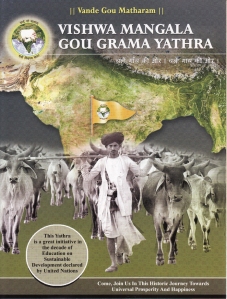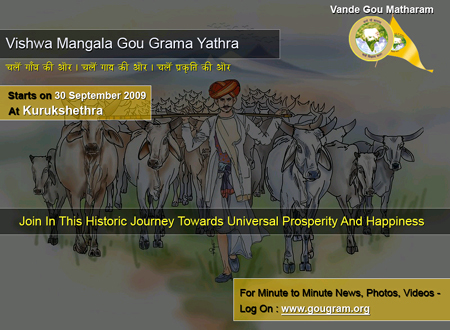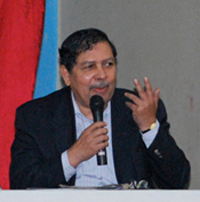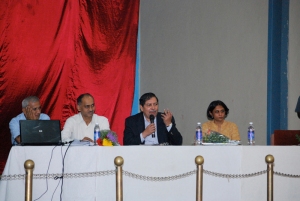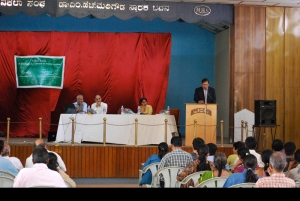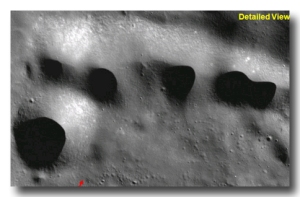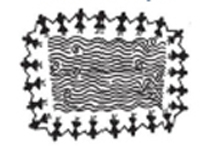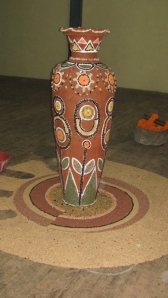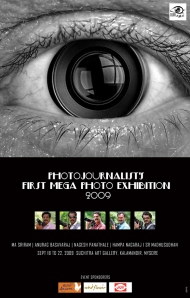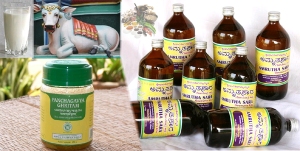Seer for Cow: Getting ready
for Nationwide Yathra

Shree Raghaveshwara Bharati Swamiji of Hosanagar ended his Chaturmasya at Kolkatha and getting ready to start Vishwa Mangala Gou Yathra from 28th of October Vijayadashami 2009. Why this yathra?
Nethrakere Udaya Shankara
Shree Raghaveshwara Bharati Swamiji of Hosanagar ended his Chaturmasya at Kolkatha and getting ready to start Vishwa Mangala Gou Yathra from 28th of October Vijayadashami 2009. Why this yathra?
This 108 day's Nationwide Yathra is intending to bring awareness about the importance and need of Cow Protection. Many organisations as well as prominent personalities including saints came forward to join their hands in this novel venture.
In the year 2007, much earlier to Deewali, the festival of lights, Gou Puja or Cow Puja was performed in Bangalore in various extensions like Kacharakanahalli, Raja Rejeshwari Nagar, Rajaji Nagar, Sanjaya Nagar, R.T. Nagar, Basavanagudi, Varthur, Koramangala, and Girinagar and so on since 4 months. Seer of Sri Ramachandrapur Math Sri. Raghaveshwar Bharti Swamiji named it as 'Gou Sandhya' means evening of Cow.
On that day Gou Rathyatra with the statues of various breeds of Indian Cows moveed on the main streets of the extensions with all festivity, farmers from in and around brought their cows and oxes for exhibition, doctors held Gavya Treatment camp whole day apart from discussions and speeches on the importance of Indian Breed Cows on the evening meetings. Then all participants in the programmes took the oath given by Sri Raghaveshwar Bharti Swamiji to protect and conserve the Indian Breed of cows for the future generation of India. The programme ended with the Gou Puja by Swamiji, guests and thousands of women who brought Arati from their homes.
This programme ran for 4 months in Bangalore ended with with large scale Programme of ‘Koti Neerajana' or showing Crores of lights to Cows by more than a lakh woman at Palace Grounds on Novermber 18th 2007.
On the end of this month’s together programme, several Muslim ladies also came forward to show light to the cows at the moment of ‘Koti Neerajana’.
Swamiji termed this Abhiyan as Second Struggle of Independence and appealed everybody to participate in it forgetting all caste, creed, political differences as it is only way to remove all financial difficulties of our people especially farmers and bring prosperity to the future generations.
Why this agitation?: The main intention of this agitation is to protect and conserve the Indian Breeds of Cattle from extinction. Ramachandrapura Math started it with its project "Kamadugha' some years back.
There were more than 70 breeds of Indian Cows in India before independence. But after independence they have reduced to 27-30 breeds. Indian breeds of cattle which were like the backbone of our farmers and agriculture started to perish after we achieved Green Revolution and White Revolution using chemical fertilizers and modern machineries. Lakhs of farmers also committing suicides in recent years. Reason for this is our dependence on foreign cattle breed for white revolution and chemical fertilizers for our agriculture. One more reason for this unfortunate situation is that we forgot the fact that cow is not only for milk but for the entire life.
Actually on the course of evolution through the ages Indian Cows have developed characteristics which are acclaimed all over the world. They are sturdy, disease resistant and adaptable to different climates and countries. They are easy and economical to maintain, absorb energy from the sunrays through solar pulse on their back and yield high quality of milk which has less cholesterol. Panchagavya made from these Indian Cow’s milk, ghee, curds, urine and dung has many medicinal properties which are being used in Gavya Chikitsa to cure ailments like cancer, arthritis, stomach disorders and skin diseases. Researches have showed that cow urine is useful to cure more that 165 diseases. Only Desi Bullocks could be used in agriculture and transport. Apart from these Cow dung is best fertilizer to farms.
In this backdrop, Raghaveshwara Bharati Swamiji thought that massive programme to bring awareness about the use of Indian Breed of Cows and importance of them is the only way to prosper our rural people especially farmers. He wanted to enlighten the people that Cow is not only for milk, it's urine and dung has more value compared to milk and for that purpose he started the Project Kamadugha.
Under Project Kamadugha, Ramachandrapur Math started more than 18 'Amruthadhara Goushalas' in Karnataka starting from Hosanagara to Kaggalipur in Bangalore to protect and conserve about 27 breeds of Cows which were collected from all over India, some from Pakistan also. Swamiji has planned to increase these Goushalas to 108.
Apart from setting up of Goushalas, Math has established Bharatiya Gou Bank to help farmers when they feel it is difficult to maintain cows. Farmers can leave their cows in the Gou Bank and take them back after their difficulties over. Math has also started Amrutasatva Project for use of cow dung and urine in agriculture, Amrutha Bharati Gavya Hospitals, Gavya Dairies to purchase Cow Urine and established Gou Raksha Parishats to protect cows from selling to slaughter houses by the way of purchasing them. Math has also established small scale units to produce Gou Arka, tooth powder, soap, dhoopa and variety of cosmetics from cow urine which are healthier than chemical cosmetics.
Object of all these programmes is to bring awareness that Cow is useful in its entire life, Urine of Cow as well as Ox is useful and has medicinal value, and cow urine could bring more income than cow milk to farmers.
Math has already conducted Gou Rathayathra in Karnataka and Kerala in 2005, Nine day Vishwa Gou Sammelana at Hosanagara during April 2007 to bring awareness on the above said issues. Bangalore programme of Gou Sandhya is the continuation of this awareness campaign.
What is the result of this Gou Sandhya? ‘Several Doctors are coming forward to give Gavya Treatment and several Industrialists are getting prepared to establish Cow Urine and Cow Dung based industries in rural areas’ Swamiji say.
Cow Urine Collection Centers in the lines of Milk Dairies should be established so that people could realize that Cow Urine is more profitable compared to milk. Then definitely Protection and conservation of Cow becomes effective and it leads the society to healthier and prosperous life, Swamiji adds.
Here are some answers by Raghaveshwar Swamji to some questions.
·* How you think Cow Urine is economical compared to Milk?
·** We kept the price of Rs. 100 per liter to Cow Urine. Actually it is more in Rajasthan. There is plenty of demand for Cow Urine in state, our collection is not sufficient. For medicine Urine of Indian Breed Cow, Calf and Ox could be used. Hence not only the cows, but calf and ox also could bring money to farmers. Collection of Cow Urine is easier compared to collection of Cow Milk.
·* What about cow urine purification and transportation?
·** Actually Cow Urine purification for preparing “Arka’ is very simple. It could be done in villages also by using mud pot. However experts after research said that cost for setting up of a well planned modern unit could be Rs. 3.60 Lakh. But you can get back this initial investment within two years. One such unit has been established at Jodhpur. We are planning to establish one such model unit at Bangalore.
·* What is so special with Cow Urine?
·** Urine of Indian Breed Cows has about 33 medicinal characters. It purifies blood, increases hemoglobin, cells in the body, cure ailments like cancer, arthritis, stomach disorders and skin diseases. Researches have showed that cow urine is useful to cure more that 165 diseases. Math has already produced several cosmetic items and other products like soap, Dhoopa etc from Cow Urine and Cow Dung.
·* How Urban people can help the programme?
·** Math has evolved a programme called “Gou Sanjeevini’ under which any person can protect a cow by donating minimum Rs. 3000. Normally farmers sell their cows to slaughter houses for this mere amount. Math purchases such Cows and conserve them. Urban people who keep dogs in their homes could definitely keep a cow or calf with them as the cost of maintenance of cow or calf will come out of its urine itself.
